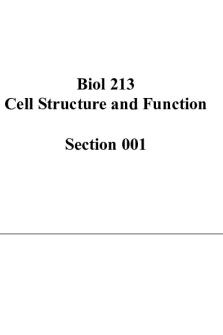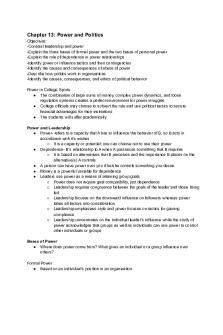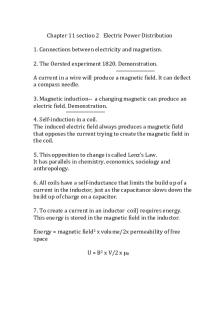Chapter Fourteen – Power PDF

| Title | Chapter Fourteen – Power |
|---|---|
| Author | Jeremy Dodson |
| Course | Mgmt & Org Behavior |
| Institution | University of Louisville |
| Pages | 9 |
| File Size | 344.2 KB |
| File Type | |
| Total Downloads | 41 |
| Total Views | 136 |
Summary
Bruce...
Description
1 Chapter Fourteen – Power, Influence, and Leadership Major Questions You Should Be Able to Answer 1. How do effective leaders use power and influence? 2. What does it take to be a successful leader? 3. Do effective leaders behave in similar ways? 4. How might effective leadership vary according to the situation at hand? 5. What does it take to truly inspire people to perform beyond their normal levels? 6. If there are many ways to be a leader, which one would describe me best? The Nature of Leadership • Leadership o The ability to influence employees to voluntarily pursue organizational goals • Personalized power o Power directed at helping oneself • Socialized power o Power directed at helping others Five Sources of Power 1. Legitimate power • Results from managers’ formal positions within the organization • Based on position within the hierarchy 2. Reward power • Results from managers’ authority to reward their subordinates 3. Coercive power • Results from managers’ authority to punish their subordinates 4. Expert power • Results from one’s specialized information or expertise 5. Referent power • Derived from one’s personal attraction (strong, visionary leadership) Question • Alex compliments his co-worker Joe on the great job he did on the weekly report, and also informs their mutual boss. Alex is used _________ power. A. Legitimate C. Reward B. Referent D. Punishment Common Influence Tactics • Soft tactics o Rational persuasion o Inspirational appeals o Consultation • Hard tactics o Exchange tactics o Coalition tactics
o Ingratiating tactics o Personal appeals
o Pressure tactics o Legitimating tactic
2 Match Tactics to Influence Outcomes • Research has shown the following o Rational persuasion, consultation, collaboration, and inspirational appeals are most effective o Be authentic to your values and beliefs o Consult rather than legitimate o “Glad handing” is not a good long-term strategy o Show subtle flattery and agreement o Learn how to influence An Integrated Model of Leadership
Trait Approaches to Leadership • Trait approaches to leadership attempt to identify distinctive characteristics that account for the effectiveness of leaders Positive Task-Oriented Traits Positive or Negative Interpersonal Attributes Intelligence Extraversion (+) Conscientiousness Agreeableness (+) Openness to experience Emotional intelligence (+) Emotional stability Narcissism (-) Positive affect Machiavellianism (-) Psychopathy (-) “Dark Side” Traits • Narcissism o Have a self-centered perspective, feelings of superiority, and a drive for personal power and glory • Machiavellianism o Displaying a cynical view of human nature and condones opportunistic and unethical ways of manipulating people, putting results over principles • Psychopathy o Characterized by lack of concern for others, impulsive behavior, and a lack of remorse when actors harm others
3 Example: Positive and Negative Traits • Leadership at TOMS o Blake Mycoskie, founder o “One for one” o Every purchase should help someone in need o Donated 60 million shoes o Restored eyesight to almost half a million o Provided safe water and childbirth services o What positive leadership traits do you think Mycoskie possesses? • Leadership at Turing Pharmaceuticals o Martin Shkreli, founder and former CEO o Business strategy of buying rights to inexpensive but life-saving prescription drugs, raising prices astronomically o Public response swift and negative o Shkreli pled not guilty – fraud related to other firms o Do you think he possesses any dark side traits? Do Women and Men Display Similar Leadership Traits? • Men displayed more task leadership and women more relationship leadership • Women used a more democratic or participative style than men, and men used a more autocratic and directive style • Female leadership was associated with more cohesion, cooperative learning, and participative communication among team members • Peers, managers, direct reports, and trained observes rated women executives as more effective than men o Men rated themselves as more effective than women evaluated themselves Four Basic Skills for Leaders • What leaders need and why o Cognitive abilities to identify problems and their causes in rapidly changing situations § Leaders must sometimes devise effective solutions in short time spans with limited information o Interpersonal skills to influence and persuade others § Leaders need to work well with diverse people o Business skills to maximize the use of organizational assets § Leaders increasingly need business skills as they advance up § Three valuable skills that most people can develop are mindfulness, curiosity, and optimism o Strategic skills to draft an organization’s mission, vision, strategies, and implementation plans § Strategic skills matter most for individuals in the top ranks of an organization § Entrepreneurs may have their strategic skills tested on a regular basis
4 Trait Theories Offer Four Conclusions 1. We cannot ignore the implications of leadership traits 2. The traits suggest the qualities you should cultivate and avoid if you want to assume a leadership role in the future 3. Organizations may want to include personality and trait assessments in their selection and evaluation processes 4. A global mind-set is an increasingly valued task-oriented trait Behavioral Approaches • Behavioral leadership approaches o Attempt to determine the distinctive styles used by effective leaders o Divided into four categories § Task-oriented behavior § Relationship-oriented behavior § Passive behavior § Transformational behavior Task-Oriented Leader Behaviors • Task-oriented leadership behaviors o These ensure that people, equipment, and other resources are used in an efficient way to accomplish the mission • Two types o Initiating-structure leadership organizes and defines what employees should be doing to maximize output o Transactional leadership clarifies employees’ roles and task requirements and provides rewards and punishments contingent on performance Relationship-Oriented Leader Behaviors • Relationship-oriented leadership o Primarily concerned with the leader’s interactions with his or her employees • Four types o Consideration o Empowering leadership o Ethical leadership o Servant leadership Consideration and Empowering Leadership • Consideration o Leader behavior that is concerned with group members’ needs and desires and that is directed at creating mutual respect or trust • Empowering leadership o Represents the extent to which a leader creates perceptions of psychological empowerment in others • Psychological empowerment o Employees’ belief that they have control over their work o Increasing meaningfulness, self-determination, competence, and progress
5 Ethical Leadership • Ethical leadership o Represents normatively appropriate behavior that focuses on being a moral role model o Includes communicating ethical values to others, rewarding ethical behavior, and treating followers with care and concern Servant Leadership • Servant leadership focuses on providing increased service to others – meeting the goals of both followers and the organization – rather than to oneself Ten Characteristics of Servant Leader 1. Focus on listening 2. Ability to empathize with others’ feelings 3. Focus on healing suffering 4. Self-awareness of strengths and weaknesses 5. Use of persuasion rather than positional authority 6. Broad-based conceptual thinking 7. Ability to foresee future outcomes 8. Belief the are stewards of their employees and resources 9. Commitment to the growth of people 10. Build community within and outside the organization Passive Leadership • Passive leadership o Form of leadership behavior characterized by a lack of leadership skills • Laissez-faire leadership o A form of “leadership” characterized by a general failure to take responsibility for leading Some Practical Implications of the Behavioral Approaches • Two conclusions o A leader’s behavior is more important than his or her traits § It is important to train managers on the various forms of task and relationship leadership o There is no one best style of leadership § How effective a particular leadership behavior is depends on the situation at hand Situational Approaches • Situational approaches to leadership o Belief that effective leadership behavior depends on the situation at hand o Also called the contingency approach • Two approaches o The contingency leadership style o The path-goal leadership style
6 The Contingency Leadership People • The contingency leadership model developed by Fiedler o Determining if a leader’s style is (1) task-oriented or (2) relationship-oriented and if that style is effective for the situation at hand o Uses the least preferred coworker (LPC) scale, in which workers rank the coworker they least enjoyed working with and rate him or her § Friendly/unfriendly, tense/relaxed, efficient/inefficient o The higher the score, the more the relationship-oriented; the lower the score, the more task-oriented Three Dimensions of Situational Control • Leader-member relations o Reflects the extent to which the leader has the support, loyalty, and trust of the work group • Task structure o Extent to which tasks are routine and easily understood • Position power o Refers to how much power a leader has to make work assignments and reward and punish Representation of Fiedler’s Contingency Model
Question 1. Rayford is head of a task force consisting of his peers from other departments in the organization. Rayford has A. High leader-member relations C. High position power B. High task structure D. Low position power
7
The Path-Goal Leadership Model • Path-goal leadership model developed by House o The effective leader increases employees’ motivation by clarifying the paths, or behavior, that will help them achieve goals, and provides them with support o Two contingency factors, or variables – employee characteristics and environmental factors – cause some leadership behaviors to be more effective than others House’s Path-Goal Theory
Applying Situational Theories • How can you make situational theories work for you? o Step one § Identify important outcomes o Step two § Identify relevant leadership behaviors o Step three § Identify situational outcomes o Step four § Match leadership to the conditions at hand o Step five § Decide how to make the match
8 The Uses of Transformational Leadership • Transformational leadership o Employees are encouraged to pursue organizational goals over self-interests o Leaders are influenced by individual characteristics and organizational culture o Whereas transactional leaders try to get people to do ordinary things, transformational leaders encourage their people to do exceptional things Four Key Behaviors of Transformational Leadership • Inspirational motivation o “Let me share a vision that transcends us all” • Idealized influence o “We are here to do the right thing” • Individualized consideration o “You have the opportunity to grow and excel here” • Intellectual stimulation o “Let me describe the great challenges we can conquer together” Implication of Transformational Leadership for Managers • It can improve results for both individuals and groups • It can be used to train employees at any level • It requires ethical leaders The Ethical Things Top Managers Should Do to Be Effective Transformational Leaders • Employ a code of ethics o The company should create and enforce a clearly stated code of ethics • Choose the right people o Recruit, select, and promote people who display ethical behavior • Make performance expectations reflect employee treatment o Develop performance expectations around the treatment of employees; these expectations can be assessed in the performance-appraisal process • Emphasize the value of diversity o Train employees to value diversity • Reward high moral conduct o Identify, reward, and publicly praise employees who exemplify high moral conduct Question • Jim, a manager, uses rewards and discipline to motivate subordinates, but does this as a way of helping them reach their full potential. This is called A. Contingent leadership C. Developmental consideration B. Transformational leadership D. Democratic leadership
9 The Leader-Member Exchange (LMX Model) • This model is based on the idea that one of two distinct types of leader-member exchange relationships evolve, and these exchanges are related to important work outcomes o In-group exchange § A partnership characterized by mutual trust, respect and liking o Out-group exchange § A partnership characterized by a lack of mutual trust, respect and liking...
Similar Free PDFs

Chapter Fourteen – Power
- 9 Pages

Fourteen Points OF Quaid
- 2 Pages

Power point chapter 1
- 71 Pages

Chapter 7_Heat Power
- 20 Pages

Chapter 10 Power and Influe
- 122 Pages

Chapter 11 Investment power point
- 17 Pages

Chapter 6-Steam Power Plant
- 39 Pages

Chapter VI Of Paternal Power
- 3 Pages

Chapter 10 Power and Conflict
- 9 Pages
Popular Institutions
- Tinajero National High School - Annex
- Politeknik Caltex Riau
- Yokohama City University
- SGT University
- University of Al-Qadisiyah
- Divine Word College of Vigan
- Techniek College Rotterdam
- Universidade de Santiago
- Universiti Teknologi MARA Cawangan Johor Kampus Pasir Gudang
- Poltekkes Kemenkes Yogyakarta
- Baguio City National High School
- Colegio san marcos
- preparatoria uno
- Centro de Bachillerato Tecnológico Industrial y de Servicios No. 107
- Dalian Maritime University
- Quang Trung Secondary School
- Colegio Tecnológico en Informática
- Corporación Regional de Educación Superior
- Grupo CEDVA
- Dar Al Uloom University
- Centro de Estudios Preuniversitarios de la Universidad Nacional de Ingeniería
- 上智大学
- Aakash International School, Nuna Majara
- San Felipe Neri Catholic School
- Kang Chiao International School - New Taipei City
- Misamis Occidental National High School
- Institución Educativa Escuela Normal Juan Ladrilleros
- Kolehiyo ng Pantukan
- Batanes State College
- Instituto Continental
- Sekolah Menengah Kejuruan Kesehatan Kaltara (Tarakan)
- Colegio de La Inmaculada Concepcion - Cebu






